Southeast Asia provides a real treat for the tastebuds, bringing perfect balance to the five flavors: salty, spicy, sour, bitter, and umami.
The exotic flavors of Thailand, Cambodia, and Vietnam are delightfully challenging, offering the fiery heat of fresh chili, combined with the sweetness of cane sugar, the saltiness of fish sauce and soy, the herbal bitterness of holy basil, and the sweet umami of coconut milk.
You probably think that you don’t have time to rustle up a Thai Green Curry during the week. But, remember: southeast Asia is the domain of the stir-fry – it’s all quick, healthy, and super-tasty.
All southeast Asian curries are made from a paste – and those are what we’re going to be making today. Once you’ve created your paste, just fry it lightly in a little sunflower oil until the spices release their aroma, and add your favorite stir-fry ingredients.
Getting hungry?
Let’s get started.
Thai Green Curry Paste
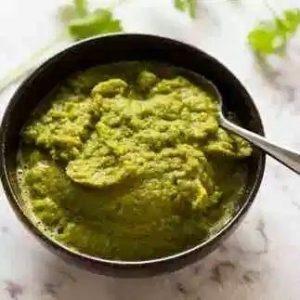
Sure, you can buy some delicious ready-made pastes from the supermarket, but there’s nothing like homemade, is there?
You’re in total control over the flavors with a homemade paste. Not keen on spicy? Cut back on the chili. Not a fan of fish sauce? Substitute it for soy sauce or leave it out altogether.
Remember: no one enjoys the smell of fish sauce – it’s kind of revolting. But it adds an absolutely mouth-watering salty umami-ness to your food!
INGREDIENTS:
- 4-6 medium green chilies – roughly chopped, deseeded (or leave the seeds in for more fire)
- 2 shallots, chopped
- 2in piece of fresh ginger, peeled grated
- 2 garlic cloves, crushed
- Bunch of fresh cilantro, include the stalks and roots if you can
- 2 stalks of lemongrass, crushed and chopped (2tbsp dried if you can’t get fresh)
- 1 lime, juiced, and zested
- 8 kaffir lime leaves (if unavailable, add the zest of 1 extra lime)
- 1in piece of galangal, peeled, chopped (add a little more ginger if unavailable))
- 1 tbsp cilantro seeds, crushed
- 1 tsp ground cumin seed
- 1 tsp black peppercorns, crushed
- 2 tsp Thai fish sauce (or soy sauce if you can’t handle fish sauce)
- 3 tbsp olive oil
OK – don’t panic. That’s a lot of ingredients, but your curry is going to be positively ambrosial. You can freeze your herbs if you buy too many – fresh cilantro and lemongrass freeze remarkably well.
If you can’t get shallots, add spring onion. If you can’t get galangal, add more ginger.
Now comes the simple bit. You’ll need a food processor with a sharp blade.
METHOD:
- Crush your garlic by placing the flat edge of a kitchen knife or cleaver over the garlic clove on your chopping board. Press down with your other hand until the garlic splits.
- Do the same with your lemongrass, and chop it into smaller pieces.
- Add all of the other ingredients into a food processor. Don’t forget the oil and fish sauce. Blitz until the ingredients form into a smooth paste.
And that’s it. Easy as 1, 2, 3.
In less than 10 minutes, you’ll have your very own green curry paste. This recipe is suitable for eight portions. You can freeze what you don’t use straight away.
To make your full green curry, follow these steps:
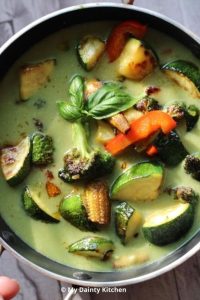
© My Dainty Kitchen
- Add 1 tbsp veg or sunflower oil to your wok or pan and heat until very hot.
- Drop a chopped clove of garlic and fry briefly.
- Add 1 tablespoon of your paste and stir it in the oil for a few seconds, cooking the spices and releasing the aromas.
- Pour in 1 can of coconut milk. Bring it to a gentle simmer.
- Add 2 tsp Thai fish sauce, 1 tsp of caster sugar, and your protein of choice. Chicken, tofu, or fish works perfectly. Simmer the sauce until your protein is fully cooked – it should be around 8mins for chicken, but always test before you eat.
- Add cooked potatoes, green beans, warm them through in the sauce.
- Add 2 shredded lime leaves (or some lime zest) and a handful of holy basil. Eat as soon as you can.
Thai Red Curry
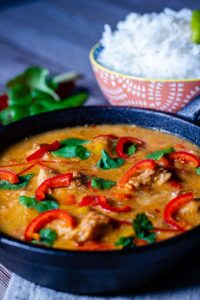
There’s more than just a color difference between a red- and green Thai curry.
Red curries are generally spicier with a more savory edge than the tangy green curry. Green curries contain holy basil, cilantro- and lime leaf, which gives its beautiful green color, whereas red curries demand LOTS of red chilies.
Of course, you can make a red curry with fewer spicy elements – just adjust to taste.
But never be afraid of adding spice – I’ve had so many bland homemade curries because the host has chosen to hold off on the chili. A curry needs a kick – but adjust that kick accordingly. If you don’t want a wallop, minimize the chilis. But it should never be a caress – always a kick.
Red Curry Paste
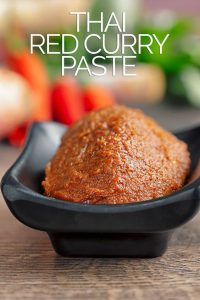
Just like the green curry, an authentic Thai red curry is made from a prepared paste. And if you thought the green curry paste was easier than you thought – well, this is the same.
Of course, you can buy red curry paste from the supermarket. But where’s the fun in that?
Traditionally, green and red curry pastes are made by adding the ingredients to a mortar and pestle and grinding everything until it becomes a smooth paste. But that takes over thirty minutes!
Of course, that kind of blows the 15-minute meal timescale, and it’s MUCH more manageable with a food processor. Just make sure that the blade is super-sharp.
Shrimp paste – approach with caution!
This recipe uses shrimp paste. If you thought fish sauce smelled bad, you ain’t smelt nothing yet!
You’ll open the pot and wonder whether it’s fit for human consumption. It is – it tastes MUCH nicer than it smells. It adds a fantastic umami saltiness. Don’t let the pong put you off – red curry’s not the same without it.
INGREDIENTS:
- 16 dried chilies, chopped into 1/2inch pieces
- 2 tbsp lemongrass (prepared as for green)
- 1 tbsp grated galangal (prepared as for green)
- 4 garlic cloves, peeled
- 1 tbsp shrimp paste in oil
- ½ tsp ground coriander seed
- ½ tsp ground cumin seed
- 1 tbsp chopped cilantro, inc stems and roots
- 2 red shallots
- 1 tsp lime zest
- ¼ cup of the chili soaking water
There are a few more processes with red curry, but that’s mainly because we’re using fiery dried chilies. If you can’t get dried, add a handful of red chilies – be generous.
METHOD:
- Soak your dried chilies in freshly boiled water, and leave for 30 minutes. Taste the chilies after soaking to get an idea of their heat. Adjust the amount accordingly.
- Once soaked, remove the chilis and reserve the water.
- Put the chilis into your food processor along with all of the other ingredients.
- Add ¼ cup of the chili water, and blitz on high until the ingredients come together into a smooth paste. It should take around 20-30 seconds with a powerful food processor, although it could take up to a minute. Add a little more water if the paste needs help to come together.
- Scrape the paste into a jar or airtight container and store it in the fridge. It keeps for around three days in the refrigerator, or you can freeze it in cube trays – fine for a couple of months.
Jungle Curry
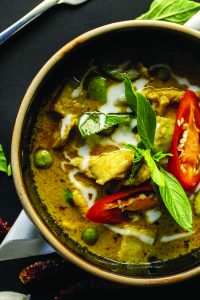
Well, we’re going super-exotic now and heading off into the jungle. And once you have your red curry paste, it doesn’t take long to pimp it up into a jungle curry paste.
Jungle curries are spicy and don’t include coconut milk, so it’s an excellent alternative to anyone who isn’t a fan of coconut.
INGREDIENTS:
- 4-5 tbsp red curry paste (use the recipe above)
- 3-5 green Thai chilies (or add as many as your palette can cope with!)
- 2 Tbsp grachai (aka fingeroot), chopped
- 2 tbsp lemongrass, sliced thinly
Grachai (or fingeroot) is sometimes known as Chinese ginger. The long, thin roots resemble fingers (hence the name).
If you can’t get grachai, just use the same amount of galangal or ginger.
METHOD:
To make your jungle curry paste, add everything to a food processor (with a sharp blade) and blitz until smooth!
Easy. Less sweet than a green curry, which provides space to allow the herbal notes to penetrate through.
Yum!
Let’s get cooking
Once you’ve tried making your own Southeast Asian pastes, you’ll never go back to bland supermarket jars.
Midweek meals CAN be exciting. Cooking with paste bases elevates the most humble of ingredients into a delight for the taste buds!
Happy eating!

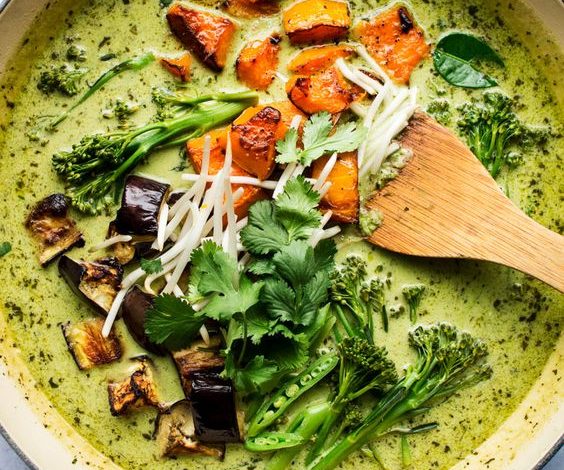
Leave a Comment